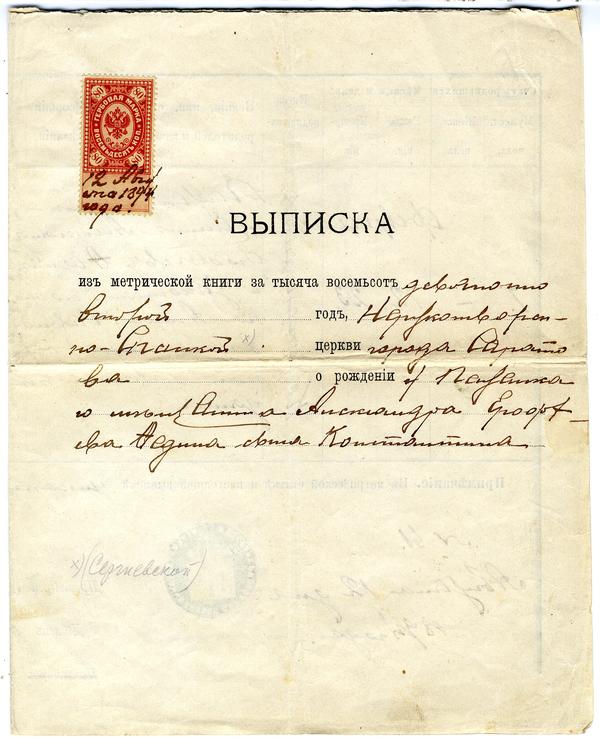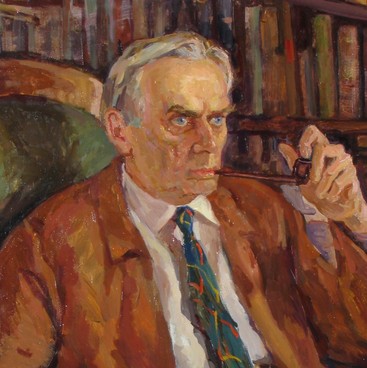Before the Russian Revolution, a vypiska was a document that served as a certification of both a child’s birth and baptism. The modern equivalent of a vypiska from a parish register (birth certificate) is sometimes called by its old name, metrika, from the Russian word for “parish register” – metricheskaya kniga. The word was borrowed from the Polish metryka during the reign of Peter the Great. The Russian dictionary compiled by Vladimir Dal gives the following meanings for metrika: 1. parish register of births, deaths and marriages; 2. certificate of birth and baptism; 3. collection of acts on noble families, book of genealogy.
The document shown at this exhibit is written on a form that was printed on both sides. The full name of the document is printed on the front side: “Vypiska (Record Extract) from the 1892 parish register of the Church of the Saviour Not Made by Hands in Saratov on the birth of Konstantin, son of Alexander Yeforeev Fedin, a Penza townsperson.” Nearby a stamp is affixed: “Duty stamp. Eighty kopecks.” The paper has been folded in half.
The reverse side of the document features a printed table with the following columns filled in by hand in black ink:
Child number (for males and females separately). Written in the “male” field is the number 7.
Day and month (date of birth and date of baptism, written separately): “12 February (Birth); 23 February (Baptism).”
Given name: “Konstantin”
Title, first name, patronymic, last name and religion of parents: “Penza townsperson Alexander Yeforeev Fedin and his legal wife Anna Pavlova, both of Orthodox faith.”
Title, first name, patronymic and last name of the godparents: “Private (honourable) citizen Semyon Ivanov Moshkov and wife of a Saratov tradesman Lidia Timofeeva Stepanova.”
Sacrament of baptism performed by: “Archpriest Lavrentiy Nechaev and Subdeacon Feodor Kamensky.”
Witness signatures, signed at will. Column left blank.
Below the table there is a note reading: “No erasures or amendments have been made in this record extract.”
In the lower left corner there is a handwritten entry: “No. 61. The 12th day of August 1894.”
Next to this is the seal of the Church of the Saviour Not Made by Hands with a silhouette of the three-domed church. To the right are the signatures of the archpriest (senior priest, rector of the church) and the deacon (a clergyman of the first, lowest degree of the priesthood).
The document shown at this exhibit is written on a form that was printed on both sides. The full name of the document is printed on the front side: “Vypiska (Record Extract) from the 1892 parish register of the Church of the Saviour Not Made by Hands in Saratov on the birth of Konstantin, son of Alexander Yeforeev Fedin, a Penza townsperson.” Nearby a stamp is affixed: “Duty stamp. Eighty kopecks.” The paper has been folded in half.
The reverse side of the document features a printed table with the following columns filled in by hand in black ink:
Child number (for males and females separately). Written in the “male” field is the number 7.
Day and month (date of birth and date of baptism, written separately): “12 February (Birth); 23 February (Baptism).”
Given name: “Konstantin”
Title, first name, patronymic, last name and religion of parents: “Penza townsperson Alexander Yeforeev Fedin and his legal wife Anna Pavlova, both of Orthodox faith.”
Title, first name, patronymic and last name of the godparents: “Private (honourable) citizen Semyon Ivanov Moshkov and wife of a Saratov tradesman Lidia Timofeeva Stepanova.”
Sacrament of baptism performed by: “Archpriest Lavrentiy Nechaev and Subdeacon Feodor Kamensky.”
Witness signatures, signed at will. Column left blank.
Below the table there is a note reading: “No erasures or amendments have been made in this record extract.”
In the lower left corner there is a handwritten entry: “No. 61. The 12th day of August 1894.”
Next to this is the seal of the Church of the Saviour Not Made by Hands with a silhouette of the three-domed church. To the right are the signatures of the archpriest (senior priest, rector of the church) and the deacon (a clergyman of the first, lowest degree of the priesthood).




